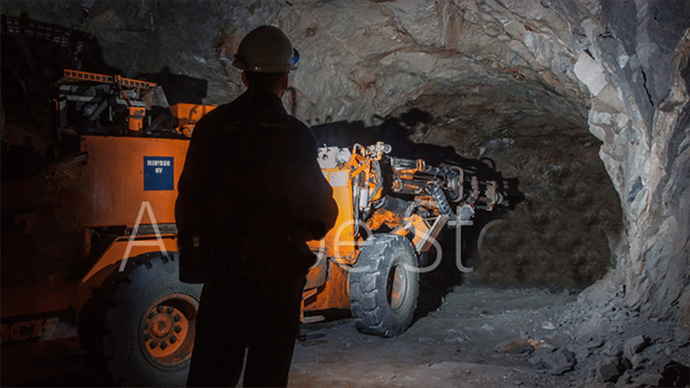Condition monitoring solutions for open-pit mines
| Written by Mark Buzinkay

No video selected
Select a video type in the sidebar.
Why are condition monitoring solutions for mines in high demand?
Open pit mines are essential to global supply chains, providing critical materials such as metals, minerals, and construction resources. However, they face persistent challenges related to safety, regulatory compliance, sustainability, and profitability. This is where condition monitoring of mine sites plays a transformative role. Condition monitoring involves the continuous or periodic assessment of equipment and environmental conditions through sensors, data analytics, and predictive models.
When it comes to safety, condition monitoring helps detect early signs of equipment failure, such as in haul trucks, excavators, or conveyors. It also enables the monitoring of slope stability using advanced geotechnical sensors like inclinometers and radar systems. By identifying potential hazards before they escalate, condition monitoring reduces the risk of catastrophic incidents that could endanger workers.
On the regulatory side, condition monitoring assists in maintaining accurate records of equipment performance and environmental controls, which is crucial for compliance with tightening regulations. It supports transparent reporting for audits, tracks environmental factors such as dust, noise, and vibrations, and ensures machinery operates within permissible emission levels.
In terms of sustainability, condition monitoring contributes by identifying inefficiencies in energy usage, for instance, by reducing fuel consumption and idle times. It extends the lifespan of equipment, thus minimizing waste and the environmental impact of replacements. Additionally, it allows maintenance to be performed based on actual conditions rather than predetermined schedules, preventing unnecessary interventions and conserving resources.
From a profitability perspective, condition monitoring minimizes unplanned downtime by enabling maintenance teams to address issues before they result in breakdowns. It optimizes maintenance schedules, ensuring machines are neither over-serviced nor neglected, and helps forecast spare parts needs, which lowers inventory costs and improves operational planning.
Beyond these direct benefits, condition monitoring also feeds valuable data into digital twin systems and supports autonomous operations. For example, autonomous haul trucks rely heavily on continuous monitoring to operate safely and efficiently, while simulation models built on monitoring data enhance mine planning and extraction strategies.
Condition monitoring in open pit mines often uses advanced technologies like IoT sensors, drones, radar, and data analytics platforms to provide real-time insights. These insights allow mine operators to make smarter decisions, balancing safety, productivity, and profitability.
In summary, condition monitoring shifts open pit mining operations from a reactive to a proactive approach. It enhances worker safety, supports regulatory compliance, advances sustainability objectives, and protects business profitability by maintaining control over the health and performance of both equipment and the surrounding environment.
The trend toward condition monitoring solutions
A global survey by Bentley Systems and Seequent involving 400 mining industry experts highlights the growing adoption of automated condition monitoring in mining operations. Over the past two years, nearly 29% of mine owners and one-third of service providers have accelerated using automated real-time data collection, moving away from manual monitoring methods. This shift is driven by the need to improve safety, meet sustainability goals, reduce operational risks, and enhance efficiency.
The survey reveals that mine owners, often larger and better resourced, are leading the way in automation, with 72% of their data now collected automatically, compared to 68% for service providers. Owners also integrate a wider range of data sources, combining condition monitoring with asset management systems, geoscience data, and digital twins to gain a comprehensive view of mine performance. Automation has reduced the challenges traditionally associated with monitoring, such as data compatibility and sampling errors, allowing companies to increase the number of monitored variables and improve data quality.
Both mine owners and service providers report significant benefits from automation, including lower costs, improved productivity, expanded market opportunities, and recurring revenue streams. Additionally, the drive for transparency and stronger stakeholder engagement is pushing companies to enhance public data sharing, building trust within the communities they operate.
Looking ahead, automation is expected to continue advancing, with mine owners projecting 80% automation in their monitoring systems within two years. The survey underscores that automation does not replace human expertise but complements it, freeing workers from manual data collection to focus on higher-value tasks. Key lessons from the transition include the importance of process standardization, infrastructure readiness, data security, and employee education. Overall, automation is seen as essential for future-proofing mining operations and meeting evolving environmental, safety, and governance expectations. (1)
A few real-world examples of condition monitoring
Rio Tinto – Autonomous Trucks and Predictive Maintenance
Rio Tinto operates one of the most advanced mining fleets in the world, especially at their Pilbara iron ore operations in Western Australia. They use autonomous haulage systems (AHS) and condition monitoring to track vehicle health, such as tyre pressure, engine performance, and structural stress. This reduces the risk of equipment failure, improves fuel efficiency, and extends asset life. Moreover, predictive maintenance supported by real-time data reduces unplanned downtime significantly, keeping operations smooth. (2)
BHP – Slope Stability Monitoring at Escondida Mine
BHP, at their Escondida copper mine in Chile, uses advanced geotechnical monitoring systems to track slope movement in real time. By combining radar technologies and predictive analytics, they can identify slope instability well before it risks workers or equipment. This proactive approach has improved site safety and helped BHP avoid costly disruptions, keeping the pit operational while adhering to strict safety regulations. (3)
Anglo American – Remote Condition Monitoring and Environmental Impact Reduction
Anglo American has deployed remote condition monitoring across its global mining operations, including open-pit sites in South Africa and Brazil. Using IoT sensors, they collect data on equipment performance, environmental impact (such as dust and noise levels), and energy consumption. This enables more innovative maintenance schedules, extends machinery lifespan, and supports their goal of reducing operational greenhouse gas emissions by 30% by 2030. (4)
Freeport-McMoRan – Mill and Equipment Monitoring at Grasberg Mine
At the Grasberg open-pit mine in Indonesia, Freeport-McMoRan has integrated condition monitoring to track the performance of crushers, conveyors, and mill equipment. Vibration analysis and temperature monitoring help prevent mechanical failures that could halt production. This system has dramatically improved maintenance efficiency and reduced downtime, ensuring better profitability for one of the largest copper and gold mines globally. (5)
How is mining security involved in condition monitoring solutions?
Mine security plays a crucial role alongside condition monitoring in open pit operations because both are integral to risk management and operational continuity. While condition monitoring focuses primarily on the health and performance of equipment and environmental factors, mining security addresses threats to physical assets, personnel, and data infrastructure.
In open pit mines, security concerns range from theft and vandalism to unauthorized site access and cyber threats targeting automated systems. As mines adopt more advanced technologies for condition monitoring — such as IoT devices, remote sensors, and telemetry — the importance of cybersecurity increases significantly. These digital systems must be protected from hacking, data breaches, and system manipulation, as disruptions could compromise safety, damage equipment, or halt production entirely.
Physical security is equally important. Mines are often located in remote areas, making them vulnerable to intrusions or tampering with monitoring equipment. Security systems like surveillance cameras, perimeter control, and access management help safeguard both personnel and critical monitoring infrastructure. Without robust security measures, even the most sophisticated condition monitoring system can become ineffective if its sensors are damaged, data streams are interrupted, or false data is introduced.
Moreover, security supports regulatory compliance and public trust. Many regulations require the protection of operational data and the safety of workers on site. By integrating security with condition monitoring solutions, mine operators ensure a holistic approach to risk management, combining early detection of mechanical or environmental issues with the prevention of external threats (read more about mine protection).
In short, mining security acts as a protective shield for the technological backbone of modern mine monitoring, ensuring that the flow of accurate, reliable data remains uninterrupted and that operations remain safe and resilient against both physical and digital threats.
FAQ: Condition Monitoring Solutions for Open Pit Mines
Why is condition monitoring critical for open pit mines?
Condition monitoring is essential in open pit mining because it helps detect early signs of equipment failure, slope instability, and environmental hazards before they become critical. By continuously tracking machinery performance and site conditions, operators can prevent accidents, reduce unplanned downtime, and maintain compliance with strict safety and environmental regulations. This proactive approach not only enhances worker safety but also improves operational efficiency and extends the lifespan of costly mining equipment.
How do modern condition monitoring systems work in open pit environments?
Modern condition monitoring systems in open pit mines rely on a combination of IoT sensors, real-time data collection, and advanced analytics. These systems monitor variables such as vibration, temperature, structural movement, air quality, and dust levels. Data is transmitted remotely, often via telemetry, and analyzed using specialized software to provide actionable insights. Operators can use this data to predict maintenance needs, optimize equipment usage, and respond swiftly to emerging risks, ensuring smoother and safer mine operations.
What are the benefits of automating condition monitoring in open pit mining?
Automating condition monitoring offers numerous advantages for open pit mines. It reduces manual data collection efforts, lowers the likelihood of human error, and provides faster, real-time insights for decision-making. Automated systems enable broader monitoring coverage, including hard-to-reach areas, and support integration with digital platforms like asset management systems and digital twins. This leads to better risk management, cost savings from reduced downtime and maintenance, and stronger compliance with sustainability and stakeholder expectations.
Takeaway
Condition monitoring is rapidly becoming a cornerstone of modern open pit mining, helping operators improve safety, reduce costs, and meet growing sustainability demands through automation and real-time insights. By integrating advanced monitoring systems, mines can detect risks early and optimize equipment performance. Equally important, robust security measures protect these monitoring technologies from physical damage and cyber threats, ensuring data integrity and operational continuity. For open pit operations, the combination of condition monitoring and security creates a resilient foundation for safer, more efficient, and future-proof mining activities.
Delve deeper into one of our core topics: Mining security
Glossary
Radar (Radio Detection and Ranging) is a technology that uses radio waves to detect and monitor objects and surfaces. In open pit mining, radar systems are widely used for slope stability monitoring, as they can continuously scan pit walls and detect minute movements in real time, even in poor visibility. This allows operators to anticipate landslides or failures, improving safety and operational efficiency. (6)
References:
(1) https://northamericanmining.com/index.php/2025/03/24/insight-into-condition-monitoring/
(2) https://www.riotinto.com/news/releases/2023/Intelligent-Mining
(3) https://www.bhp.com/sustainability/safety
(4) Anglo American, "How technology is changing mining", Anglo American Digital Transformation Report, 2023. https://www.angloamerican.com/technology
(5) Freeport-McMoRan, "Technology and Innovation", Freeport Annual Report 2023. https://fcx.com/sustainability/technology-innovation
(6) Turner, A. K. (2018). Instrumentation and Monitoring of Slopes. CRC Press.

Author
Mark Buzinkay, Head of Marketing
Mark Buzinkay holds a PhD in Virtual Anthropology, a Master in Business Administration (Telecommunications Mgmt), a Master of Science in Information Management and a Master of Arts in History, Sociology and Philosophy. Mark spent most of his professional career developing and creating business ideas - from a marketing, organisational and process point of view. He is fascinated by the digital transformation of industries, especially manufacturing and logistics. Mark writes mainly about Industry 4.0, maritime logistics, process and change management, innovations onshore and offshore, and the digital transformation in general.
Related Product



